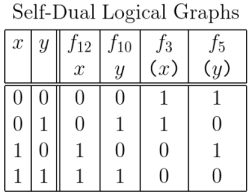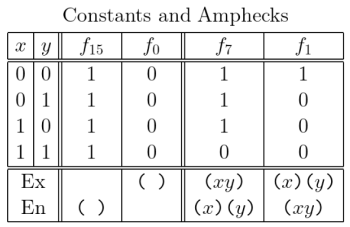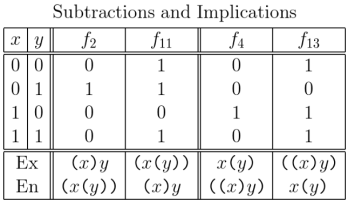Semiotic Transformations
Re: Transformations of Logical Graphs • (8) • (9) • (10) • (11)
Re: Interpretive Duality as Sign Relation • Orbit Order
Taking from our wallets an old schedule of orbits, let’s review the classes of logical graphs we’ve covered so far.
Self-Dual Logical Graphs
Four orbits of self‑dual logical graphs, were discussed in Episode 9.
The logical graphs denote the boolean functions
in that order. The value of each function
at each point
in
is shown in the Table above.
Constants and Amphecks
Two orbits of logical graphs called constants and amphecks were discussed in Episode 10.
The constant logical graphs denote the constant functions
- Under
the logical graph whose text form is “ ” denotes the function
and the logical graph whose text form isdenotes the function
- Under
the logical graph whose text form is “ ” denotes the function
and the logical graph whose text form isdenotes the function
The ampheck logical graphs denote the ampheck functions
- Under
the logical graph
denotes the function
and the logical graphdenotes the function
- Under
the logical graph
denotes the function
and the logical graphdenotes the function
Subtractions and Implications
The logical graphs called subtractions and implications were discussed in Episode 11.
The subtraction logical graphs denote the subtraction functions
The implication logical graphs denote the implication functions
Under the action of the duality the logical graphs for the subtraction
and the implication
fall into one orbit while the logical graphs for the subtraction
and the implication
fall into another orbit, making these two partitions of the four functions orthogonal or transversal to each other.
Resources
- Logic Syllabus
- Logical Graphs • Zeroth Order Logic
- Survey of Animated Logical Graphs
- Survey of Semiotics, Semiosis, Sign Relations
cc: FB | Logical Graphs • Laws of Form • Mathstodon • Academia.edu
cc: Conceptual Graphs • Cybernetics • Structural Modeling • Systems Science




Pingback: Survey of Animated Logical Graphs • 7 | Inquiry Into Inquiry
Pingback: Transformations of Logical Graphs • 13 | Inquiry Into Inquiry
Pingback: Transformations of Logical Graphs • 14 | Inquiry Into Inquiry